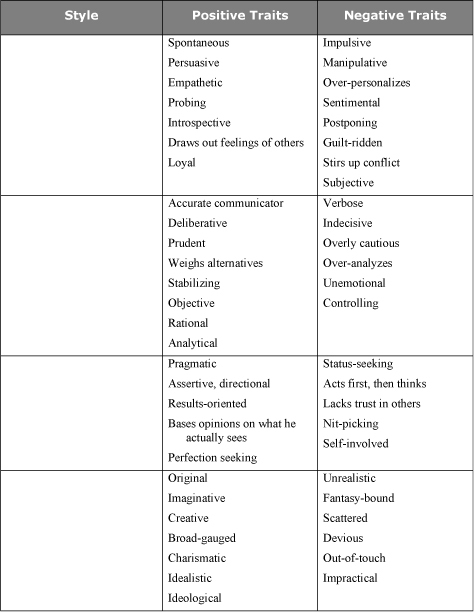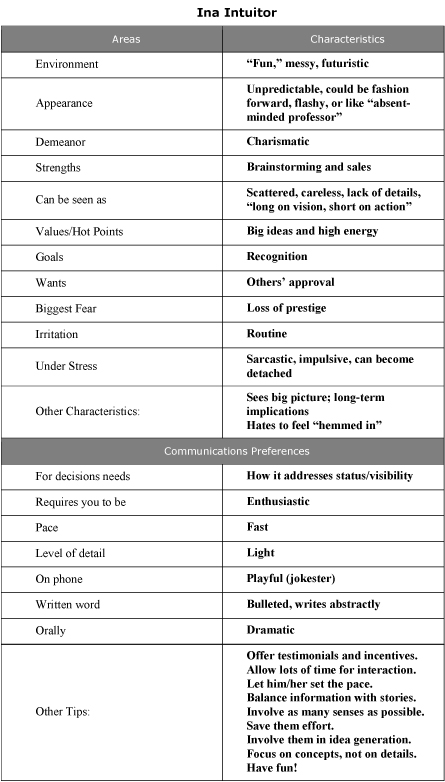Communicating with Style
Since ancient times, man has attempted to categorize the different personality styles. In ancient Greece, Hippocrates outlined four temperaments: sanguine, phlegmatic, melancholic, and choleric. Native Americans assigned personality traits to the four directions.
Carl Jung was the first to scientifically study the styles. In 1920s, he published the ground-breaking book Psychological Types in which identified four behavioral styles: the Sensor, the Intuitor, the Thinker, and the Feeler. Other theories followed and now we have dozens of models from which to choose. My favorites are:
- Myers-Briggs Indicator, based on Jung's work
- DISC, which is used almost as much as Myers-Briggs in the business world
- The Birkman Method®, based on the work of Roger Birkman
- CST, or Communicating Styles Technology
- Tony Alessandra's Platinum Rule
- The Enneagram, which explains why we do something, as well as how
Over the years, I have compiled a simple model that borrows elements from all of these. In it, I identify four personalities:
- Samuel C. Sensor
- Theodore Thinker
- Ina Intuitor
- Felicia Feeler
Let's meet them.
Exercise: Who am I?
Instructions: Which style - Samuel C. Sensor, Ina Intuitor, Theodore Thinker, or Felicia Feeler - matches which set of traits?

Meet the Styles
In reviewing this information, it is helpful to keep in mind:
- No one style is better than another. Each brings a unique set of skills into the workplace.
- Most assessments are based upon self-assessment, and as such are subject to bias.
- You have elements of each of the four styles in you, but usually one style guides your behavior most of the time. Don't expect one style to totally nail your personality. If it's sixty percent or more on target, then it's probably your style.
- Your style most likely changes under stress. I go from Samuel to Theodore when I feel pressured.
This table will further summarize individual characteristics and communications preferences for each style. As you review each style, see if you can pick out your own. How about someone whom you work with?




Hopefully, you now have a feel for each of the communications styles and what makes their socks go up and down. Did you see yourself? How about someone with whom you work?
Most of us go through life communicating with people in ways we like them to communicate with us. For example, I am a Samuel C. Sensor, so my natural tendency is to be on-point and to-the-point. Seldom would I ask personal questions; it takes too much time. When I am dealing with a Felicia or Ina, however, I must flex styles to take the time to build a relationship before launching into the business at hand. When I am communicating with a Theodore, I delve into a lot more detail than I would normally, and if I am really on, I might throw in a process or procedure for good measure.
I am not being inauthentic when I flex styles. As mentioned earlier, each of us has a little of the four styles within us. I am simply making a conscious effort to intensify the style that matches that of the person with whom I am communicating. My intention is never to manipulate, but to connect. By flexing my style, I am only fertilizing the soil so that communication and connection can grow.
It's important to note that this handout is only intended to provide a brief overview of the four communications styles. This topic is worthy of a book unto itself. In the back you'll find a reading list for more information. I especially recommend The Platinum Rule by Tony Alesandra and Michael J. O'Connor which inspired much of my model.
# # #
PHOTO Available on Request
Copyright 2007, All rights reserved
The Career Engineer" Randy Siegel works with organizations to take high-potential employees and give them the leadership and communications skills they need to be successful as they rise through the organization. Purchase his book PowerHouse Presenting: Become the Communicator You Were Born to Be through Amazon.com, and subscribe to his complimentary monthly e-Newsletter at www.buildyourleaders.com.



